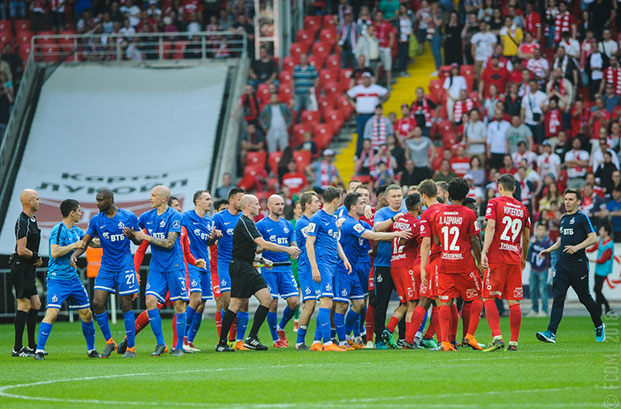Club history. 1945 — 1991

Throughout decades
In the forties of the last century, Dynamo Moscow (together with CDKA) dominated in Soviet football. A powerful attack led by Konstantin Beskov as well as a mobile midfield guaranteed territorial and game advantage over any opponent. In defense, the goalkeeper Aleksey Khomich played the key role. In the fifties, Dynamo continued to shine and participated in a race for the championship title in competition with Spartak. During that period Lev Yashin's goalkeeping talent gained a foothold, and his recognition as a legend came in the sixties. Lev Yashin has been invited to the Rest of the World XI and European national team. He was also named the best footballer of the year on the European continent.
In the seventies, Dynamo began to lose their leading position in Soviet football, and in the next decade the team faced a long crisis. Frequent rotation of coaching staff and players' reshuffling led to hard times when the White-Blues teetered on the brink of relegation from the Soviet Top League. At the very beginning of the nineties the situation began to improve.
Dynamo Moscow remained the only club that participated in all 54 championships during the Soviet period.
Tactics metamorphose
The tactical pattern of the game has changed so much that the football of the early 90s turned out to be completely different from the game that prevailed in the second half of the 40s. The classic W system, three centre-backs, two midfielders and five forwards with insides playing deeper, dominated in Soviet football until 1962. And Dynamo Moscow, together with other sides, were not an exception. In 1963, the White-Blues won the USSR championship for the tenth time. The team used the so-called Brazilian tactical formation on regular basis. It included four defenders, two midfielders and four forwards.
In the year of the next championship title (1976), the number of attackers decreased again – one forward moved to the midfield. Ten years later, the midfield was already loaded with four footballers at the expense of the number of forwards.
All this is about the starting line-up. It is worth of remark that the players' functions have also changed a lot. In early days goalkeepers played mainly in the goal area, while in the 60s, following the example of Lev Yashin, they began to play actively around the perimeter of the penalty box. Defenders started raiding to the opposite half of the pitch and even score goals, which was impossible to imagine in the 40s, and even in the 50s.
The T-shirts' numbers that appeared in 1946 served as an identifying mark for a long time (for example, No. 2 corresponded to a right-back, and No. 11 was related to a left inside). By the end of the 80s this rule turned out to be violated, and at the beginning of the 90s it was completely forgotten.
Dynamo players in national teams
In 1952 the USSR national team has been revived after a forced break linked with the Great Patriotic War in order to take part in the Olympic Games. Dynamo players' call-up to the national team was always incontestable. The senior national team managed to do without Dynamo Moscow footballers only in four seasons (1975, 1981, 1982, 1984) throughout the entire Soviet period.
The call-up of Dynamo football players to the USSR Olympic team looks even more impressive. For ten Olympic cycles, the country's national team has played 73 matches and counted on the White-Blues' footballers in 63 of them. No other club can boast of such an achievement.
